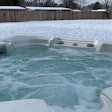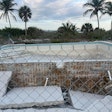
Okay, there are states in the United States where pool maintenance can go from smooth sailing to a full-blown disaster faster than you can say, "Avast there, ye scalawags!" And I live in one of them. It's those pesky hurricanes, you see, that just keep coming. You need a pirate mentality to really thrive as a service pro here, where the ocean comes into the backyard on a regular basis, and you find yourself barking in high winds such maritime phrases as, "Batten down the hatches!"
We've faced several events in Florida recently that will forever change how we service pools along the Gulf Coast. Swimming pools from Cape Coral to the Big Bend have been swallowed by the Gulf of Mexico multiple times — so much so that the sea has staked its claim, literally calling dibs and demanding everyone else back off. When the water receded, it often left pools looking like sand traps at a golf course, with only the handrail visible as evidence of the pool below.
First, before you can even think of remediation, if there is any standing water, you must determine if any hazards exist; this is Florida. To do this, you are going to have to taste the water.
You heard me correctly. Take a sip. If it tastes salty — we know there are sharks present. If it does not taste salty, we know to be on the lookout for gators. Jk! Don't ever drink the (possibly feces-laden) pool water, but DO be on the lookout for sharks and gators swimming in the flooded streets.
Beach Entry
Beyond poo, hurricanes can fill your clients' swimming pools with any number of things — weary animals, bits of decking from the next county, sometimes the neighbor's gas grill. There is a high probability of sewage and fertilizer runoff, adding a new level to the game of disgust. But there's sure to be sand — thousands upon thousands of pounds of sand — giving a whole new meaning to the term "beach entry."
The tools you choose to remove this unwanted feature will largely depend on the size of the pool and how much beach has entered. Of sand, is it half full? Or half empty. The way you answer that question dictates your course. If it's an amount you can deal with, like about as much as the layer of leaves and slime on the floor of a foreclosed pool you just Green-2-Cleaned, get out the snow shovels. As you already know, you are one of the few Floridians to own this tool of the frozen hellscape up north. I like snow shovels for this job because the soft plastic edges prevent the floor from looking like you just cleaned it with a spirograph.
A large capacity wet vac can help. Use one of those 20-gallon jobs that can hold a couple of hundred pounds, but keep in mind that when filled, wheels or not, it's going to be as easy to move as an inflatable hot tub full of jello shots. Get some heavy-duty buckets to move that sand you've collected. Don't cheap out and use a tablet bucket — that handle will kill your hand — spend a few dollars and get a sturdy 5-gallon bucket with an ergonomic handle; you'll be happy you did.
If you have a giant pool filled with what amounts to a full section of Waikiki, you should consider a Bobcat or a Kubota (you can't afford Caterpillar) mini excavator. Excavators are a little better because of the higher reach, just make sure you get the rubber-tipped bucket. This way, you can quickly remove a lot of sand while minimizing futzing up the pool shell. But it's not just the sand you need to worry about.
When Godzilla came splashing ashore, causing a mini tidal wave submerging people's houses and swimming pools under 15 feet of water, that big lizard raised the groundwater to unforeseen levels, and now that groundwater is pushing on all sides of the pool.
If you think the movie gave you some fantastic jump scares, that's nothing compared to the one you'll get if that pool comes smashing out of the ground. Right now, that sand may be the only thing holding it in place.
Don't Waive the Waiver
I assume you're all set to proceed legally and have the proper insurance. If not — and you're planning to go ahead anyway — I'm sorry, but we might have to rethink our friendship. However, if you've got whatever licenses, certifications, and insurance add-ons (like pop-up coverage) that your local legislators require, then we're good. We can totally hang.
Establish a test well or use a piezometer to determine the groundwater level before you take another step. This is crucial for deciding whether well points are necessary to prevent hydrostatic pressure issues. DO NOT forget the pièce de résistance: a contract with Waiver on it, lovingly crafted by a lawyer who lives and breathes contract law. This kind of paperwork is not just useful, it's downright seductive.
And needless to say, fiberglass or vinyl pools — Fuhgeddaboudit; they are done; they are no more; they are in heaven now with Sparky, your first dog. We're quoting a new pool here.
Proceed with your concrete rescue, but with care. Even with rubber-tipped buckets, plaster can be scratched or cracked. Manually clearing edges with those snow shovels I was talking about will help you avoid surface damage. Work methodically from the shallow to the deep end.
Uneven removal of sand will create pressure imbalances, which will stress the pool walls and increase the risk of cracks or deformation. Simultaneous water filling can prevent structural lift or shifting, but it will make the sand more challenging to remove. Well-point dewatering systems (aforementioned) are the way we lessen the odds of a groundwater snafu. These systems consist of shallow perforated pipes, or well points, installed around the pool connected to a high-capacity pump.
The pump draws groundwater away from the pool area, lowering the water table and reducing hydrostatic pressure. This process helps stabilize the pool structure, making sand removal safer and preventing the pool from catapulting out and stopping your heart. You'll pump the water to a specified location, such as a drainage area, in compliance with local regulations. The same with the sand. You can't just put the beach back on the BEACH! Remember that sand removed from swimming pools is subject to state and local regulations. Sunshine state? Don't you mean Regulations state?! Listen, don't get yourself in trouble because you didn't feel like being bothered by asking the county or township.
Barnacles!
Now for the part you never thought you'd have to deal with in your pool service pro life — barnacles! Aye, matey, you may experience barnacle growth on pool walls after sand and water removal on a pool that has taken you a minute to get to. A few factors can contribute to this, such as how long the pool sat filled with seawater and the pool's surface condition. Even in a world of obstinate marine organisms, barnacles are like ex-con tough guys, and you'll find removing them as difficult as removing a drunken Vin Diesel from a bar in which he feels he's been insulted.
 "After pulling the hydrostatic line and draining the pool, we did a diluted acid wash. It helps loosen most barnacles, which have been forming since Hurricane Helene. So for these, we had to get a scraper and physically scrape them off. Then, we rewashed behind them. Then, we refilled the pool and did a hot start."
"After pulling the hydrostatic line and draining the pool, we did a diluted acid wash. It helps loosen most barnacles, which have been forming since Hurricane Helene. So for these, we had to get a scraper and physically scrape them off. Then, we rewashed behind them. Then, we refilled the pool and did a hot start."
—Affordable Pools and Spas, Clearwater, Fla.
The good thing is that the freshwater you fill the pool with when you're done will significantly reduce the probability of reoccurring barnacle growth. Even your saltwater pools at 3,000 ppm are at one-tenth the saline level these cockamamie crustaceans need to survive. The sudden drop in salinity alone will cause osmotic stress, leading to cell damage and death. So, this is a one-off, but similar to a pool with horrific black algae (Cyanobacteria), barnacles will leave 'adhesion scars' on the plaster due to the snot they use to cement themselves to surfaces.
If you don't think removing barnacles is cool, keep in mind that in the movie The Replacements (2000), Keanu Reeves plays Shane Falco, a former quarterback turned replacement player during a professional football strike. Before rejoining the football world, Shane worked as a boat cleaner, specifically removing barnacles from the hulls of boats.
So, it's cool.
A problem that will persist beyond the barnacles is the significant amount
of salt the plaster will absorb after
a storm surge. Yeah, it's in there, and it'll be coming back with a vengeance, leaching from the walls and floor into the freshwater like Jake Paul memes across my social feed. This salty saboteur triggers scaling and efflorescence, turning that plaster pool you just did a hurricane remediation on into a crusty mess with potentially corroded metal fixtures. Left unchecked, this can lead to nodules galore.
To fight back, you must go full Jack Reacher on the cleanup. Pressure wash every square inch of the walls and floor to blast away embedded salt. Bring in the big guns — a mild acid wash to dissolve those stubborn residues — if the salt's clinging on like a hustler who only got half the money up front.
After the cleanup crew clocks out, refill the pool with fresh water, balance the chemistry, and keep an eye on those salinity levels. YES!!! Testing for salt levels in your non-saltwater pools has become your new religion.
This is not likely a one-and-done. Salt is relentless, and it won't give up its new home without a fight. You may have to drain and refill the pool multiple times. This we call dilution flushing. Think of it like an exorcism but for saline-possessed plaster. 'Dimmy, why did you do this to me? Please Dimmy, I'm afraid.' –Regan Teresa MacNeil, The Exorcist. No matter what she says, or how many times her head spins around, bear down and stay the course. Salinity levels will eventually stabilize as the water pulls out the embedded salt.
Charge! ARG!
How do you charge for sand, seawater, salt and barnacle removal? Like a pirate! A respectable, professional and reasonable, yet avaricious, pirate.
The exact answer will vary by region, but if they are not forthcoming with the booty, it clearly indicates that the fellow pirates in your market are not charging enough for storm surge remediation. I don't want you to take advantage of people, but I also don't want them to take advantage of you.
Just make sure it's worth sailing the high seas of pool service under heavy weather conditions.
This article first appeared in the January 2025 issue of AQUA Magazine — the top resource for retailers, builders and service pros in the pool and spa industry. Subscriptions to the print magazine are free to all industry professionals. Click here to subscribe.












































